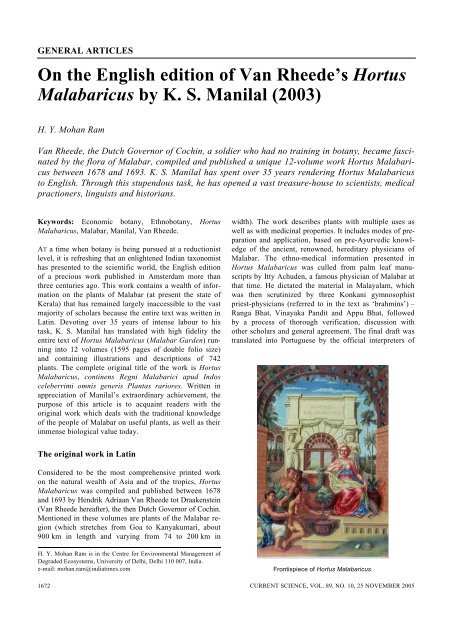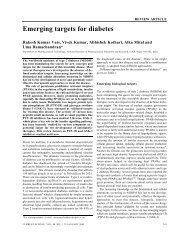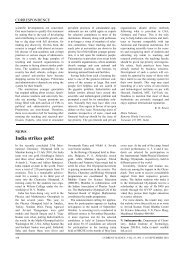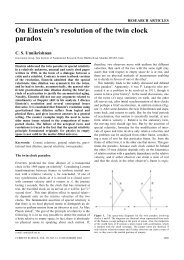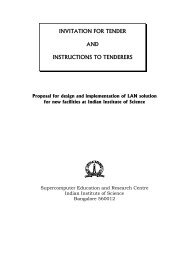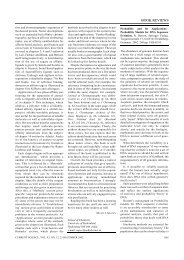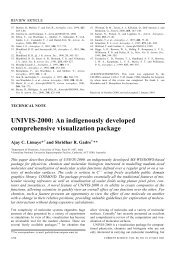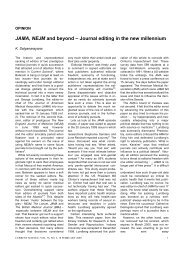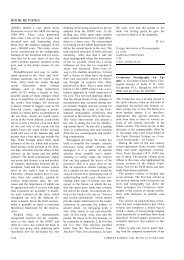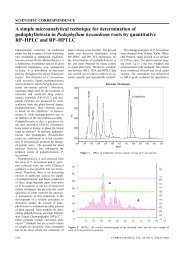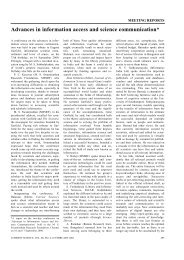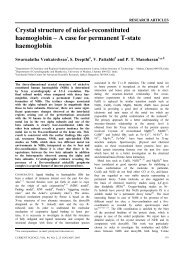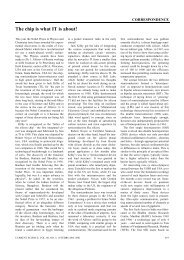On the English edition of Van Rheede's Hortus Malabaricus by K. S. ...
On the English edition of Van Rheede's Hortus Malabaricus by K. S. ...
On the English edition of Van Rheede's Hortus Malabaricus by K. S. ...
Create successful ePaper yourself
Turn your PDF publications into a flip-book with our unique Google optimized e-Paper software.
GENERAL ARTICLES<br />
<strong>On</strong> <strong>the</strong> <strong>English</strong> <strong>edition</strong> <strong>of</strong> <strong>Van</strong> Rheede’s <strong>Hortus</strong><br />
<strong>Malabaricus</strong> <strong>by</strong> K. S. Manilal (2003)<br />
H. Y. Mohan Ram<br />
<strong>Van</strong> Rheede, <strong>the</strong> Dutch Governor <strong>of</strong> Cochin, a soldier who had no training in botany, became fascinated<br />
<strong>by</strong> <strong>the</strong> flora <strong>of</strong> Malabar, compiled and published a unique 12-volume work <strong>Hortus</strong> <strong>Malabaricus</strong><br />
between 1678 and 1693. K. S. Manilal has spent over 35 years rendering <strong>Hortus</strong> <strong>Malabaricus</strong><br />
to <strong>English</strong>. Through this stupendous task, he has opened a vast treasure-house to scientists, medical<br />
practioners, linguists and historians.<br />
Keywords: Economic botany, Ethnobotany, <strong>Hortus</strong><br />
<strong>Malabaricus</strong>, Malabar, Manilal, <strong>Van</strong> Rheede.<br />
AT a time when botany is being pursued at a reductionist<br />
level, it is refreshing that an enlightened Indian taxonomist<br />
has presented to <strong>the</strong> scientific world, <strong>the</strong> <strong>English</strong> <strong>edition</strong><br />
<strong>of</strong> a precious work published in Amsterdam more than<br />
three centuries ago. This work contains a wealth <strong>of</strong> information<br />
on <strong>the</strong> plants <strong>of</strong> Malabar (at present <strong>the</strong> state <strong>of</strong><br />
Kerala) that has remained largely inaccessible to <strong>the</strong> vast<br />
majority <strong>of</strong> scholars because <strong>the</strong> entire text was written in<br />
Latin. Devoting over 35 years <strong>of</strong> intense labour to his<br />
task, K. S. Manilal has translated with high fidelity <strong>the</strong><br />
entire text <strong>of</strong> <strong>Hortus</strong> <strong>Malabaricus</strong> (Malabar Garden) running<br />
into 12 volumes (1595 pages <strong>of</strong> double folio size)<br />
and containing illustrations and descriptions <strong>of</strong> 742<br />
plants. The complete original title <strong>of</strong> <strong>the</strong> work is <strong>Hortus</strong><br />
<strong>Malabaricus</strong>, continens Regni Malabarici apud Indos<br />
celeberrimi omnis generis Plantas rariores. Written in<br />
appreciation <strong>of</strong> Manilal’s extraordinary achievement, <strong>the</strong><br />
purpose <strong>of</strong> this article is to acquaint readers with <strong>the</strong><br />
original work which deals with <strong>the</strong> traditional knowledge<br />
<strong>of</strong> <strong>the</strong> people <strong>of</strong> Malabar on useful plants, as well as <strong>the</strong>ir<br />
immense biological value today.<br />
The original work in Latin<br />
Considered to be <strong>the</strong> most comprehensive printed work<br />
on <strong>the</strong> natural wealth <strong>of</strong> Asia and <strong>of</strong> <strong>the</strong> tropics, <strong>Hortus</strong><br />
<strong>Malabaricus</strong> was compiled and published between 1678<br />
and 1693 <strong>by</strong> Hendrik Adriaan <strong>Van</strong> Rheede tot Draakenstein<br />
(<strong>Van</strong> Rheede hereafter), <strong>the</strong> <strong>the</strong>n Dutch Governor <strong>of</strong> Cochin.<br />
Mentioned in <strong>the</strong>se volumes are plants <strong>of</strong> <strong>the</strong> Malabar region<br />
(which stretches from Goa to Kanyakumari, about<br />
900 km in length and varying from 74 to 200 km in<br />
H. Y. Mohan Ram is in <strong>the</strong> Centre for Environmental Management <strong>of</strong><br />
Degraded Ecosystems, University <strong>of</strong> Delhi, Delhi 110 007, India.<br />
e-mail: mohan.ram@indiatimes.com<br />
1672<br />
width). The work describes plants with multiple uses as<br />
well as with medicinal properties. It includes modes <strong>of</strong> preparation<br />
and application, based on pre-Ayurvedic knowledge<br />
<strong>of</strong> <strong>the</strong> ancient, renowned, hereditary physicians <strong>of</strong><br />
Malabar. The ethno-medical information presented in<br />
<strong>Hortus</strong> <strong>Malabaricus</strong> was culled from palm leaf manuscripts<br />
<strong>by</strong> Itty Achuden, a famous physician <strong>of</strong> Malabar at<br />
that time. He dictated <strong>the</strong> material in Malayalam, which<br />
was <strong>the</strong>n scrutinized <strong>by</strong> three Konkani gymnosophist<br />
priest-physicians (referred to in <strong>the</strong> text as ‘brahmins’) –<br />
Ranga Bhat, Vinayaka Pandit and Appu Bhat, followed<br />
<strong>by</strong> a process <strong>of</strong> thorough verification, discussion with<br />
o<strong>the</strong>r scholars and general agreement. The final draft was<br />
translated into Portuguese <strong>by</strong> <strong>the</strong> <strong>of</strong>ficial interpreters <strong>of</strong><br />
Frontispiece <strong>of</strong> <strong>Hortus</strong> <strong>Malabaricus</strong>.<br />
CURRENT SCIENCE, VOL. 89, NO. 10, 25 NOVEMBER 2005
Hendrik Adriaan <strong>Van</strong> Rheede tot Draakenstein (1636–1691).<br />
<strong>the</strong> Dutch East India Company. From Portuguese, <strong>the</strong> text<br />
was rendered into Dutch and <strong>the</strong>nce to Latin. The introductions,<br />
forewords and dedications given separately in<br />
various volumes also contain valuable insights into <strong>the</strong><br />
cultural, social, political, historical and linguistic conditions<br />
<strong>of</strong> 17th century Malabar.<br />
The descriptions <strong>of</strong> plants comprising <strong>the</strong>ir habit, foliage,<br />
flowers, fruits, colour, smell, taste and practical value appear<br />
in <strong>Hortus</strong> <strong>Malabaricus</strong> under <strong>the</strong>ir Malayalam names.<br />
The plates bearing illustrations have been inscribed in<br />
Roman, Malayalam and Arabic scripts. Konkani names<br />
are given in Devanagari script. Nearly all <strong>the</strong> plants are<br />
illustrated (<strong>of</strong> <strong>the</strong> 791 plates, 712 are in double folio size<br />
and 79 in folio size). The expenses <strong>of</strong> publication were met<br />
<strong>by</strong> ‘<strong>the</strong> widow <strong>of</strong> John <strong>Van</strong> Someren, <strong>the</strong> heir <strong>of</strong> John<br />
<strong>Van</strong> Dyck, Henry, and <strong>the</strong> widow <strong>of</strong> Theodore Boom’ (title<br />
page, vol. 1).<br />
<strong>Van</strong> Rheede employed over 200 knowledgeable local<br />
collectors to bring to him whole plants or <strong>the</strong>ir twigs bearing<br />
flowers, fruits and seeds in different seasons. Many <strong>of</strong> <strong>the</strong>se<br />
plants were introduced in <strong>the</strong> Company’s gardens. Four<br />
soldiers from <strong>the</strong> Dutch Army were asked to execute <strong>the</strong><br />
illustrations, to which descriptions were added in his<br />
presence. Then, a board <strong>of</strong> 15–16 expert physicians and<br />
botanists from various parts <strong>of</strong> Malabar was engaged to<br />
examine <strong>the</strong> materials prepared and present its opinion<br />
about <strong>the</strong> curative properties <strong>of</strong> <strong>the</strong> plants collected. <strong>Van</strong><br />
Rheede was most impressed <strong>by</strong> <strong>the</strong> authority as well as<br />
<strong>the</strong> civility and culture with which <strong>the</strong> discussions took<br />
place without ‘acerbity, mental disturbance or neglect to<br />
GENERAL ARTICLES<br />
respect o<strong>the</strong>rs’ opinion’ (preface to vol. 3, page xviii).<br />
Hundreds <strong>of</strong> bundles <strong>of</strong> all <strong>the</strong> plants collected and put in<br />
folded papers indicating <strong>the</strong>ir names, uses and description<br />
were shipped to Amsterdam, where <strong>the</strong>y were thoroughly<br />
scrutinized <strong>by</strong> several experts.<br />
Thus <strong>Van</strong> Rheede’s <strong>Hortus</strong> <strong>Malabaricus</strong> is <strong>the</strong> result <strong>of</strong><br />
about 30 years <strong>of</strong> compiling and editing <strong>by</strong> a team <strong>of</strong> <strong>the</strong><br />
best among 17th century European physicians, pr<strong>of</strong>essors<br />
<strong>of</strong> medicine and botany, amateur botanists (such as Arnold<br />
Seyn, Theodore Janson <strong>of</strong> Almeloveen, Paul Herman, Johannem<br />
Munnicks, Joannes Commelinus, Abraham a Poot),<br />
Indian scholars and vaidyas (physicians) <strong>of</strong> Malabar and<br />
adjacent regions, and technicians, illustrators and engravers,<br />
toge<strong>the</strong>r with <strong>the</strong> collaboration <strong>of</strong> company <strong>of</strong>ficials, clergymen<br />
(D. John Caesarius and Fa<strong>the</strong>r Ma<strong>the</strong>w <strong>of</strong> St. Joseph).<br />
This stupendous undertaking <strong>by</strong> <strong>the</strong> Dutch Governor <strong>of</strong><br />
Cochin was greatly assisted <strong>by</strong> <strong>the</strong> King <strong>of</strong> Cochin and<br />
<strong>the</strong> ruling Zamorin <strong>of</strong> Calicut.<br />
<strong>Van</strong> Rheede – an incomparable soldier and a<br />
protagonist <strong>of</strong> Malabar flora<br />
<strong>Van</strong> Rheede was born in 1636 in an influential and noble<br />
family that owned castles and country houses, which gave<br />
<strong>the</strong>m access to <strong>the</strong> Equestrian Order <strong>of</strong> Utrecht. <strong>Van</strong> Rheede,<br />
who lost his parents in his boyhood, had no scientific<br />
training. He left <strong>the</strong> Ne<strong>the</strong>rlands when just 14 years old<br />
and entered <strong>the</strong> service <strong>of</strong> <strong>the</strong> Dutch East India Company<br />
at <strong>the</strong> age <strong>of</strong> 20. He was exposed to exotic flora at <strong>the</strong><br />
Cape <strong>of</strong> Good Hope, Batavia and Ceylon (Sri Lanka). He took<br />
part in <strong>the</strong> conquest <strong>of</strong> Ceylon and Malabar while serving<br />
under Admiral <strong>Van</strong> Goens. For his exemplary performance<br />
in <strong>the</strong> battles and devotion to duty, <strong>Van</strong> Rheede was rapidly<br />
promoted to councillor, ‘regedore major’, first captain<br />
and sergeant major <strong>of</strong> Ceylon and Commander <strong>of</strong> Malabar.<br />
He grew fond <strong>of</strong> <strong>the</strong> land and its people and secured for<br />
himself a favourable place in Malabar society and established<br />
an influential relationship with <strong>the</strong> Raja <strong>of</strong> Cochin,<br />
Vira Kerala Varma 1 . When he was asked to resign from<br />
his post in 1678, he left Cochin and spent six years in <strong>the</strong><br />
Ne<strong>the</strong>rlands. In view <strong>of</strong> his expert knowledge and talents,<br />
<strong>Van</strong> Rheede was appointed Commissioner General <strong>of</strong> <strong>the</strong><br />
Western Quarters to streamline <strong>the</strong> affairs <strong>of</strong> <strong>the</strong> Dutch East<br />
India Company in 1684. He returned to India and spent a<br />
few years in various parts, arriving in Cochin in 1691.<br />
It is remarkable that, unlike o<strong>the</strong>r colonial army commanders,<br />
<strong>Van</strong> Rheede took a keen interest in <strong>the</strong> amazingly<br />
rich flora <strong>of</strong> <strong>the</strong> region and was deeply impressed <strong>by</strong> it. In<br />
<strong>the</strong> preface to vol. 3, <strong>Van</strong> Rheede goes into raptures while<br />
describing <strong>the</strong> forests <strong>of</strong> Malabar:<br />
“...on <strong>the</strong> way I observed large, l<strong>of</strong>ty and dense forests<br />
…it was <strong>of</strong>ten very pleasant to behold on one tree,<br />
leaves, flowers and fruits <strong>of</strong> ten or twelve different<br />
kinds displayed. And yet <strong>the</strong>y did not harm this tree in<br />
CURRENT SCIENCE, VOL. 89, NO. 10, 25 NOVEMBER 2005 1673
GENERAL ARTICLES<br />
1674<br />
any way so that <strong>the</strong> trunks <strong>of</strong> such trees were very<br />
close to each o<strong>the</strong>r and very thick, or at all events <strong>the</strong>y<br />
lifted <strong>the</strong>ir heads in air to an elegant height <strong>of</strong> as much<br />
as eighty feet… and thus <strong>the</strong>se forests resembled a house<br />
<strong>of</strong> a very elegant structure ra<strong>the</strong>r than virgin forests…<br />
Since I perceived all this repeatedly, this had led me<br />
believe that I judged not without reason that this part<br />
<strong>of</strong> India was truly and rightly <strong>the</strong> most fertile part <strong>of</strong><br />
<strong>the</strong> whole world….’<br />
Until his visit to Malabar, <strong>Van</strong> Rheede had never seen giant<br />
woody climbers, nor immense trees <strong>of</strong> banyan that resembled<br />
imposing ca<strong>the</strong>drals with innumerable prop roots. He was<br />
also deeply impressed <strong>by</strong> <strong>the</strong> Malabaris who, irrespective<br />
<strong>of</strong> <strong>the</strong>ir pr<strong>of</strong>ession, were knowledgeable about plants in<br />
<strong>the</strong>ir surroundings and derived all <strong>the</strong>ir medicines from<br />
<strong>the</strong>m.<br />
<strong>Van</strong> Rheede also studied <strong>the</strong> social system <strong>of</strong> Malabar<br />
<strong>of</strong> that period. About <strong>the</strong> Konkani brahmins he states:<br />
‘Those who have <strong>the</strong> care <strong>of</strong> <strong>the</strong> ceremonies and <strong>of</strong> religion<br />
are also very numerous, and <strong>the</strong>y live in <strong>the</strong> greatest<br />
tranquility and are favoured <strong>by</strong> very ample benefices<br />
and great esteem, to which are added <strong>the</strong> gifts <strong>of</strong> <strong>the</strong><br />
pious people, so that those men can quite rightly be<br />
proclaimed <strong>the</strong> happiest men <strong>of</strong> <strong>the</strong> whole world…<br />
They do not contract marriages with persons <strong>of</strong> ano<strong>the</strong>r<br />
nation or foreigners, and yet <strong>the</strong>y permit any people <strong>of</strong><br />
whatever religion to live freely among <strong>the</strong>m. They<br />
never pass beyond <strong>the</strong> boundaries <strong>of</strong> <strong>the</strong>ir native country<br />
and yet <strong>the</strong>y do not resent <strong>the</strong> travels <strong>of</strong> foreigners’<br />
(preface to vol. 3).<br />
<strong>Van</strong> Rheede was obsessed <strong>by</strong> <strong>the</strong> desire to get <strong>the</strong> rich<br />
plant diversity <strong>of</strong> Malabar documented as accurately as<br />
possible to meet <strong>the</strong> standards <strong>of</strong> <strong>the</strong> European experts.<br />
Torn between his multifarious <strong>of</strong>ficial duties and <strong>the</strong> passion<br />
to <strong>of</strong>fer something unknown to <strong>the</strong> West, <strong>the</strong> idea <strong>of</strong> compiling<br />
a book on <strong>the</strong> natural plant wealth <strong>of</strong> Malabar was<br />
conceived <strong>by</strong> <strong>Van</strong> Rheede to prove his belief that Malabar<br />
was self-sufficient in all military and commercial requirements<br />
and, <strong>the</strong>refore, that Cochin was better suited to be<br />
<strong>the</strong> South East Asian headquarters <strong>of</strong> <strong>the</strong> Dutch overseas<br />
forces, than Colombo in Ceylon.<br />
The compilation <strong>of</strong> <strong>Hortus</strong> <strong>Malabaricus</strong> did not proceed<br />
smoothly and <strong>Van</strong> Rheede had to face countless problems –<br />
his own dismissal as Governor <strong>of</strong> Cochin; <strong>the</strong> premature<br />
death <strong>of</strong> expert botanists, Dutch physicians, trusted<br />
friends and <strong>the</strong> publishers; <strong>the</strong> need to change <strong>the</strong> plan <strong>of</strong><br />
<strong>the</strong> book after <strong>the</strong> first two volumes were completed; <strong>the</strong><br />
drying up <strong>of</strong> financial support for publishing; and above<br />
all, few takers for <strong>the</strong> book. Never<strong>the</strong>less, his energy, position,<br />
power, perseverance and resourcefulness compelled<br />
him to fulfil his goal. A detailed account <strong>of</strong> <strong>the</strong> colourful<br />
and chequered career <strong>of</strong> <strong>Van</strong> Rheede has been published<br />
<strong>by</strong> Heniger 1 . While quelling a rebellion in Malabar, <strong>Van</strong><br />
Rheede fell ill. He passed away aboard <strong>the</strong> ship Drogterland<br />
<strong>of</strong>f <strong>the</strong> coast <strong>of</strong> Bombay on 15 December 1691, while<br />
sailing from Cochin to Surat. The mausoleum built in his<br />
honour at Surat is a neglected and rarely frequented<br />
monument.<br />
The <strong>English</strong> <strong>edition</strong><br />
The <strong>English</strong> <strong>edition</strong> contains a word-for-word translation<br />
<strong>of</strong> all <strong>the</strong> 12 volumes <strong>of</strong> <strong>Hortus</strong> <strong>Malabaricus</strong>. The original<br />
style <strong>of</strong> Latin has been followed and no attempt has been<br />
made to modify or modernize it so that researchers interested<br />
in analysis and interpretation can read <strong>the</strong> text in <strong>the</strong> way<br />
it was written. The medicinal properties <strong>of</strong> <strong>the</strong> plants<br />
concerned, as originally certified <strong>by</strong> <strong>the</strong> unchallenged authorities<br />
<strong>of</strong> traditional medicine in Kerala who supplied<br />
all such information, have been translated and interpreted<br />
<strong>by</strong> Manilal. Commentaries have been given on <strong>the</strong> etymology<br />
<strong>of</strong> <strong>the</strong> Malayalam names, revealing <strong>the</strong>ir traditional uses<br />
as well as <strong>the</strong>ir botanical peculiarities. In addition, <strong>the</strong><br />
identity <strong>of</strong> all <strong>the</strong> plants and correct scientific botanical<br />
nomenclature acceptable under <strong>the</strong> International Code <strong>of</strong><br />
Botanical Nomenclature (ICBN), have been provided <strong>by</strong><br />
Manilal along with <strong>the</strong>ir important synonyms and basionyms.<br />
The exquisite illustrations have enabled Manilal to identify<br />
many <strong>of</strong> <strong>the</strong> plants up to <strong>the</strong> generic level. However, <strong>the</strong>y<br />
lack sufficient technical details <strong>of</strong> floral characters that<br />
are required <strong>by</strong> taxonomists to determine <strong>the</strong> specific<br />
name. To overcome this handicap, Manilal and <strong>the</strong> research<br />
scholars in his group have visited and collected nearly all<br />
<strong>the</strong> plants described in <strong>Hortus</strong> <strong>Malabaricus</strong> from localities<br />
where <strong>the</strong>y were originally ga<strong>the</strong>red three centuries ago.<br />
The plants and <strong>the</strong>ir floral parts were <strong>the</strong>n subjected to<br />
detailed observation and <strong>the</strong> correct identity <strong>of</strong> most was<br />
established. Their names were confirmed <strong>by</strong> consulting<br />
important herbaria in Europe and America.<br />
Considering <strong>the</strong> fact that <strong>the</strong> tools to study plants under<br />
high magnification were not available, <strong>the</strong> artists have<br />
missed out bladders in Utricularia reticulata Sm. (nelipu,<br />
vol. 9, Figure 70 m), an aquatic insectivore. There is some<br />
doubt about <strong>the</strong> identification <strong>of</strong> chunda (chundai in<br />
Tamil). Whe<strong>the</strong>r it is Solanum melongena (vol. 2, Figure 37)<br />
or S. erianthum D. Don (syn. S. verbascifolium auet; non<br />
Linn.) needs to be verified. Also to determine <strong>the</strong> species<br />
<strong>of</strong> Trapa, fruit morphometry (size <strong>of</strong> fruit, number <strong>of</strong> spines,<br />
length <strong>of</strong> spines, etc.) is important. The illustration (vol.<br />
11, Figure 37) shows no fruits. In <strong>the</strong> text, Trapa natans<br />
L. has been mentioned (p. 119) whereas <strong>the</strong> Index (vol. 11,<br />
p. 248; vol. 12, p. 352) lists it as Trapa bispinosa Roxb.<br />
Based on <strong>the</strong> work carried out <strong>by</strong> Manilal and his associates,<br />
a concise reference book An Interpretation <strong>of</strong> <strong>Van</strong><br />
Rheede’s <strong>Hortus</strong> <strong>Malabaricus</strong> was published from Berlin<br />
<strong>by</strong> <strong>the</strong> International Association <strong>of</strong> Plant Taxonomists,<br />
under <strong>the</strong>ir <strong>of</strong>ficial publication series ‘Regnum Vegetabile’ 2 .<br />
This is <strong>the</strong> only book <strong>by</strong> Indian authors published in this<br />
CURRENT SCIENCE, VOL. 89, NO. 10, 25 NOVEMBER 2005
series till date and is considered a classic, essential for any<br />
study on <strong>the</strong> taxonomy <strong>of</strong> South Asian and South East<br />
Asian plants.<br />
By presenting <strong>the</strong>se data for <strong>the</strong> first time in <strong>the</strong> <strong>English</strong><br />
<strong>edition</strong> <strong>of</strong> <strong>Hortus</strong> <strong>Malabaricus</strong>, Manilal has thrown open<br />
<strong>the</strong> doors <strong>of</strong> a vast and fascinating treasure-house to scientists,<br />
medical practitioners and historians for fur<strong>the</strong>r research.<br />
For easy reference, analyses, statistical comparisons and<br />
fur<strong>the</strong>r studies, several indexes have been provided at <strong>the</strong><br />
end <strong>of</strong> each volume. Apart from volume-wise, figure-wise<br />
indexes, full indexes <strong>of</strong> botanical names, family names,<br />
Malayalam, Portuguese, Dutch/Belgian and Konkani names<br />
have been included.<br />
Information on <strong>the</strong> medicinal uses <strong>of</strong> plants described<br />
in this book is <strong>of</strong> immense importance and current relevance,<br />
in <strong>the</strong> context <strong>of</strong> <strong>the</strong> growing global demand for natural<br />
drugs as well as <strong>the</strong> Intellectual Property Rights regime<br />
and Biological Patent Laws. By translating and interpreting<br />
this valuable document in <strong>English</strong>, Manilal has contributed<br />
significantly towards <strong>the</strong> safeguarding <strong>of</strong> our natural plant<br />
wealth and indigenous knowledge from being exploited<br />
<strong>by</strong> foreign commercial interests.<br />
The compilation and publication <strong>of</strong> <strong>Hortus</strong> <strong>Malabaricus</strong><br />
is also intimately connected with <strong>the</strong> history <strong>of</strong> India and<br />
<strong>the</strong> politics <strong>of</strong> <strong>the</strong> 17th century Ne<strong>the</strong>rlands and <strong>the</strong> prevailing<br />
social conditions <strong>of</strong> Malabar. Manilal has been<br />
studying <strong>the</strong>se aspects and has brought to light many interesting<br />
facts, some <strong>of</strong> which were included in his earlier book<br />
The Botany and History <strong>of</strong> <strong>Hortus</strong> <strong>Malabaricus</strong>, published<br />
from Rotterdam and Delhi 3 .<br />
<strong>Hortus</strong> <strong>Malabaricus</strong> is <strong>the</strong> first book in which Malayalam<br />
appears in print. As <strong>the</strong> technology was in its infancy<br />
<strong>the</strong>n, engraving <strong>the</strong> mirror images on each page was done<br />
on copper plates. The engravers at Amsterdam had no knowledge<br />
<strong>of</strong> Malayalam language or its script and this resulted<br />
in certain distortions. Malayalam has been printed in <strong>the</strong><br />
book to reproduce two certificates and to depict <strong>the</strong> names<br />
<strong>of</strong> plants alongside <strong>the</strong>ir illustrations. Manilal states that<br />
this is not only <strong>the</strong> first but <strong>the</strong> only printed book in which<br />
both <strong>the</strong> Kolezuthu and <strong>the</strong> Aryaezuthu scripts <strong>of</strong> Malayalam<br />
language and numerals are used toge<strong>the</strong>r, <strong>of</strong>fering scope<br />
for fur<strong>the</strong>r investigations <strong>by</strong> socio-linguists.<br />
The plant wealth <strong>of</strong> Malabar in mid-17th century<br />
A perusal <strong>of</strong> <strong>the</strong> 12 volumes indicates that among <strong>the</strong><br />
flowering plants a large number are trees. A break-up <strong>of</strong> plant<br />
diversity shows 67 members <strong>of</strong> <strong>the</strong> Fabaceae (bean family),<br />
20 grasses, including three bamboos, 18 ferns, several<br />
aquatic plants, 17 cucurbits, 16 orchids, 15 sedges, 10<br />
palms, 10 plants <strong>of</strong> <strong>the</strong> ginger family, two gymnosperms<br />
(Cycas circinalis and Gnetum edule) and only one moss –<br />
Bryum bicolor. Besides important native plants as well as<br />
those naturalized in <strong>the</strong> region since antiquity such as areca<br />
nut, banana, bel (bilva), black pepper, betel vine, champak,<br />
GENERAL ARTICLES<br />
coconut, elengi (bakul or bullet wood), ginger, palmyra<br />
palm, red silk cotton, sappan wood (pieces <strong>of</strong> which are<br />
boiled even today to purify drinking water in Kerala),<br />
talipot palm and turmeric, a large number <strong>of</strong> plants introduced<br />
from <strong>the</strong> New World <strong>by</strong> <strong>the</strong> Portuguese have been<br />
described. The important introductions include: sweet potato<br />
(Ipomoea batatas), papaya (Carica papaya), cashew nut<br />
(Anacardium occidentale), guava (Psidium guajava), custard<br />
apple (Annona squamosa), bullock’s heart (A. reticulata),<br />
pineapple (Ananas comosus), <strong>English</strong> pumpkin (Cucurbita<br />
moschata), chillies (Capsicum annum and C. frutescens).<br />
The inclusion <strong>of</strong> <strong>the</strong>ir names as plants <strong>of</strong> Malabar indicates<br />
that <strong>the</strong> climatic and soil conditions were suitable for<br />
<strong>the</strong>ir introduction and cultivation, and that <strong>the</strong> people had<br />
assimilated <strong>the</strong>m into <strong>the</strong>ir cuisine and culture. However,<br />
a few o<strong>the</strong>r important Portuguese introductions from <strong>the</strong><br />
New World are conspicuous <strong>by</strong> <strong>the</strong>ir absence: tapioca<br />
(which is presently a staple food crop in Kerala and in<br />
many parts <strong>of</strong> Africa), potato, groundnut, vanilla, cocoa and<br />
tobacco. A few surprising alien elements in <strong>Hortus</strong> <strong>Malabaricus</strong><br />
are Gomphrena globosa (from tropical and warm<br />
America), Aloe vera (a succulent from tropical South Africa,<br />
Malagasy and Arabia, probably introduced <strong>by</strong> <strong>the</strong> Arabs),<br />
Canna indica (from tropical America), and Ipomoea<br />
quamoclit and Mirabilis jalapa (four-o’-clock plant or<br />
marvel <strong>of</strong> Peru) from Mexico and tropical America respectively.<br />
In general all <strong>the</strong> volumes are beautifully illustrated. A<br />
few are exceptional for <strong>the</strong>ir artistic presentation and accuracy<br />
and deserve to be highlighted: Volume 1: Cocos nucifera<br />
(all drawings), Areca catechu, Corypha umbraculifera,<br />
Borassus flabellifer, Caryota urens, Bauhinia variegata,<br />
Morinda citrifolia. Volume 2: all pictures <strong>of</strong> Pandanus<br />
spp., and Cassia tora. Volume 3: C. umbraculifera (Codda<br />
panna or mountainous palm <strong>of</strong> Malabar); Cycas circinalis,<br />
Artocarpus heterophyllus, Annona squamosa, A.<br />
reticulata, Dillenia indica, Ceiba pentandra. Volume 4:<br />
Myristica malabarica, Lagerstroemia hirsuta, Calophyllum<br />
inophyllum, Guettarda speciosa, Salacia chinensis and<br />
Manilkara kauki. Volume 5: Ochlandra scriptoria,<br />
Clerodendrum inerme, Gomphia serrata. Volume 6: Hiptage<br />
benghalensis, Jasminum sambac, Tabernaemontana<br />
divaricata, Abutilon indicum, Hibiscus rosa-sinensis, H.<br />
mutabilis (all pictures), Bruguiera gymnorhiza (excellent),<br />
Butea monosperma, Cassia glauca, Caesalpinia sappan.<br />
Volume 7: Tetrastigma leucostaphylum, Piper nigrum,<br />
Gloriosa superba, Dioscorea hispida, Ipomoea batatas,<br />
Basella alba, Gnetum edule. Volume 8: Lagenaria siceraria,<br />
Cucurbita moschata, Benincasa hispida, Cucumis<br />
sativus, Luffa acutangula, L. aegyptiaca, Momordica<br />
charantia, Bauhinia scandens, Entada rheedei, Canavalia<br />
rosea, Zanonia indica (showing vivipary?). Volume 9:<br />
Ceropegia candelabrum, Nerium oleander, Neptunia<br />
prostrata (although <strong>the</strong> nodules at nodes are missing).<br />
Volume 10: Gomphrena globosa, Solanum melongena.<br />
Volume 11: Aloe vera, Elettaria cardamomum, Costus<br />
CURRENT SCIENCE, VOL. 89, NO. 10, 25 NOVEMBER 2005 1675
GENERAL ARTICLES<br />
1676<br />
Figure 9 in vol. 1 <strong>of</strong> <strong>Hortus</strong> <strong>Malabaricus</strong> depicting young and adult female plants <strong>of</strong> palmyra palm, Borassus<br />
flabellifer. Also shown are leaf, young inflorescence, flowers, whole fruits and cross-section <strong>of</strong> fruit.<br />
Figure 17 in vol. 6 <strong>of</strong> <strong>Hortus</strong> <strong>Malabaricus</strong> reproduced to show <strong>the</strong><br />
high quality illustration <strong>of</strong> fruits <strong>of</strong> palash or dhak tree, Butea<br />
Monosperma (in which only one seed develops in a pod).<br />
speciosus, Amorphophallus paeoniifolius, Colocasia esculenta,<br />
Lagenandra ovata, Nymphaea pubescens, Nelumbo<br />
nucifera, Pistia stratiotes, Ipomoea quamoclit. Volume<br />
12: Rhynchostylis retusa, Diplazium esculentum, Raphidophora<br />
pertusa, Lygodium flexuosum, Lycopodiella cernua,<br />
Saccharum spontaneum and Fimbristylis argentea.<br />
It is a tribute to <strong>the</strong> artists that several illustrations from<br />
<strong>Hortus</strong> <strong>Malabaricus</strong> have been repeatedly reproduced in<br />
learned journals and books during <strong>the</strong> past three centuries.<br />
A twig <strong>of</strong> black pepper, Piper nigrum, reproduced from figure 12<br />
in vol. 7 <strong>of</strong> <strong>Hortus</strong> <strong>Malabaricus</strong> showing young and old spikes<br />
bearing flowers and fruits.<br />
Impact <strong>of</strong> <strong>Hortus</strong> <strong>Malabaricus</strong> on Linnaeus’<br />
Species Plantarum (1753)<br />
The use <strong>of</strong> languages being considered crucial in <strong>the</strong> evolutionary<br />
history <strong>of</strong> humans, naming and classifying objects<br />
became an important activity. Long-distance travel and<br />
trade along land routes followed <strong>by</strong> journeys <strong>by</strong> sea during<br />
<strong>the</strong> age <strong>of</strong> exploration added to <strong>the</strong> pr<strong>of</strong>usion <strong>of</strong> common<br />
names <strong>of</strong> plants in both oriental and occidental languages. For<br />
CURRENT SCIENCE, VOL. 89, NO. 10, 25 NOVEMBER 2005
example, cultivated plants such as rice and soybean have<br />
several hundred names in local dialects. Attempts made<br />
<strong>by</strong> early European botanists to classify and name plants<br />
in Latin resulted in phrase-names which are polynomials.<br />
Eventually it fell to <strong>the</strong> lot <strong>of</strong> <strong>the</strong> Swedish botanist Carl Linnaeus<br />
(1707–1778) to evolve an artificial (albeit practical)<br />
system <strong>of</strong> classification (based on <strong>the</strong> number <strong>of</strong><br />
stamens and pistils in <strong>the</strong> flower) using an enormous<br />
amount <strong>of</strong> botanical data from several parts <strong>of</strong> <strong>the</strong> world<br />
in his monumental work Species Plantarum 4 . Linnaeus<br />
was also instrumental in strongly supporting <strong>the</strong> binomial<br />
system <strong>of</strong> nomenclature (already propounded <strong>by</strong> Bauhin<br />
in 1623). Since every specific name <strong>of</strong> this system consists<br />
<strong>of</strong> two parts – <strong>the</strong> generic name and <strong>the</strong> specific epi<strong>the</strong>t, it<br />
is known as <strong>the</strong> binomial system. By suffixing abbreviations<br />
<strong>of</strong> <strong>the</strong> name <strong>of</strong> <strong>the</strong> person who first published <strong>the</strong><br />
name (<strong>the</strong> term author is used for this purpose), Linnaeus<br />
solved <strong>the</strong> age-old problem <strong>of</strong> au<strong>the</strong>nticity. The author’s<br />
name is not a part <strong>of</strong> <strong>the</strong> botanical name, but is added for<br />
<strong>the</strong> purpose <strong>of</strong> precision. Thus <strong>the</strong> precise, referable, universal<br />
scientific name <strong>of</strong> <strong>the</strong> rice plant with its au<strong>the</strong>nticity came<br />
to be accepted as Oryza sativa L. It differs from <strong>the</strong> related<br />
species <strong>of</strong> ‘red rice’ from West Africa, O. glaberrima<br />
Stendel. The International Code <strong>of</strong> Botanical Nomenclature<br />
presently in vogue, accepts <strong>the</strong> year <strong>of</strong> publication <strong>of</strong><br />
Linnaeus’ work Species Plantarum (1753) as <strong>the</strong> starting<br />
point for <strong>the</strong> nomenclature <strong>of</strong> all green plants (except<br />
mosses and a few special groups <strong>of</strong> algae).<br />
Among <strong>the</strong> numerous books that Linnaeus studied thoroughly<br />
before producing Species Plantarum, only two<br />
merited his respect. He stated in his book Genera Plantarum 5 ,<br />
‘I have not put my whole trust in any author excepting<br />
<strong>the</strong> work <strong>of</strong> <strong>Hortus</strong> Elthamensis <strong>by</strong> <strong>the</strong> very celebrated<br />
Dillenius and <strong>the</strong> work <strong>of</strong> <strong>Hortus</strong> <strong>Malabaricus</strong> <strong>by</strong> <strong>the</strong> illustrious<br />
<strong>Van</strong> Rheede, having my firm conviction in <strong>the</strong>ir accurate<br />
data’ (cited from Manilal et al. 6 ). Linnaeus has included<br />
258 Malayalam names <strong>of</strong> plants from <strong>Hortus</strong> <strong>Malabaricus</strong><br />
in Species Plantarum. In his later works Linnaeus took 95<br />
more Rheedean elements. Importantly, Linnaeus adopted<br />
many Malayalam plant names to coin binomials directly<br />
or after Latinizing <strong>the</strong>m. Manilal states that, among plant<br />
names derived from Indian languages in Species Plantarum,<br />
<strong>the</strong> largest number are <strong>of</strong> Malayalam origin.<br />
Among <strong>the</strong> many plants native to <strong>the</strong> Western Ghats or<br />
those in domestication in <strong>the</strong> middle <strong>of</strong> 17th century Malabar<br />
listed in Species Plantarum (1753; 2nd edn, 1762–63)<br />
only a few are given here: Elettaria cardamomum (L.)<br />
Maton (<strong>the</strong> lesser cardamom); Areca catechu L. (<strong>the</strong> betel<br />
nut); Borassus flabellifer L. (palmyra palm), Ceropegia<br />
candelabrum L. (a beautiful wild plant that is <strong>of</strong> potential<br />
ornamental value); Cocos nucifera L. (coconut), Averrhoa<br />
bilimbi L. (bilimbi); Averrhoa carambola L. (carambola<br />
or star fruit); Ficus benghalensis L. (banyan); Ficus religiosa<br />
L. (pipal); Moringa oleifera (horse-radish tree or<br />
drumsticks); Indig<strong>of</strong>era tinctoria L. (indigo); Mangifera<br />
indica L. (mango); A. Juss (named Melia azadirachta L.<br />
GENERAL ARTICLES<br />
in <strong>Hortus</strong> <strong>Malabaricus</strong>) (neem); Michelia champaca L.<br />
(champak); Mimusops elengi L. (bakula or bullet wood);<br />
Nelumbo nucifera Gaertn. (named Nymphaea nelumbo L.<br />
in <strong>Hortus</strong> <strong>Malabaricus</strong>) (lotus); Phyllanthus emblica L.<br />
(emblic myrobalan, amla or aonla); Piper betle L. (betel<br />
leaf); Piper longum L. (Indian long pepper); Piper nigrum<br />
L. (black pepper); Tamarindus indica L. (tamarind);<br />
Nerium oleander L. (oleander); Crotalaria juncea L.<br />
(sunn hemp); Curcuma longa L. (turmeric) and Zingiber<br />
<strong>of</strong>ficinale Rose. (named Amomum zingiber L.) (ginger).<br />
A practice common among taxonomists is to honour<br />
noted botanists <strong>by</strong> naming newly discovered organisms<br />
after <strong>the</strong>m. Linnaeus erected Rheedia laterifolia L. This<br />
name was subsequently proposed as R. brasiliensis (Mart.)<br />
Planch. Triana (Bakupari in Brazil) <strong>of</strong> <strong>the</strong> family Guttiferae<br />
(Clusiaceae) to honour Rheede. This genus has now<br />
been merged with Garcinia. However, Rheede’s name<br />
has been commemorated as a specific epi<strong>the</strong>t in 35 plants,<br />
a few important ones being Strychnos rheedei C. B. Clarke;<br />
Bulbophyllum rheedei (K. S. Manilal & C. Sathish Kumar),<br />
now elevated to a new genus Rhytionanthos <strong>by</strong> Garay et<br />
al., an orchid; Calamus rheedei Griff., a rattan; Impatiens<br />
rheedei W. & A., a balsam; Ochlandra rheedei Gamble (a<br />
bamboo from Kerala); Phyllanthus rheedei W. a member<br />
<strong>of</strong> <strong>the</strong> Euphorbiaceae; and Spathodea rheedei Wall., a<br />
member <strong>of</strong> <strong>the</strong> Bignoniaceae.<br />
Itty Achuden<br />
Manilal is <strong>of</strong> <strong>the</strong> opinion that <strong>the</strong> medicinal properties <strong>of</strong><br />
plants listed in <strong>Hortus</strong> <strong>Malabaricus</strong> are based on pre-<br />
Ayurvedic traditional knowledge <strong>of</strong> <strong>the</strong> local people <strong>of</strong><br />
Malabar. This raises several questions. Who were <strong>the</strong> people<br />
<strong>of</strong> Malabar? Were <strong>the</strong>y aware <strong>of</strong> Ayurvedic knowledge<br />
before <strong>Hortus</strong> <strong>Malabaricus</strong> was compiled? When did Ayurveda<br />
actually reach Kerala? Not being familiar with <strong>the</strong><br />
history <strong>of</strong> Kerala, I could get no clear-cut answers to <strong>the</strong>se<br />
questions. However, a perusal <strong>of</strong> <strong>the</strong> various uses <strong>of</strong><br />
plants listed in <strong>Hortus</strong> <strong>Malabaricus</strong> indicates that <strong>the</strong>y are<br />
quite different from those listed in Ayurveda. For example,<br />
Asparagus <strong>of</strong>ficinalis, well known for its use as a galactogogue<br />
in Ayurveda, was employed for some o<strong>the</strong>r purposes<br />
<strong>by</strong> <strong>the</strong> traditional vaidyas <strong>of</strong> Malabar. There is a strong<br />
indication that <strong>the</strong> ethnobotanical and ethnomedical uses<br />
in Malabar were <strong>the</strong> outcome <strong>of</strong> empirical knowledge.<br />
The most remarkable Indian figure associated with<br />
<strong>Hortus</strong> <strong>Malabaricus</strong> is Itty Achuden, <strong>Van</strong> Rheede’s key<br />
informant. What is known about him? What was <strong>the</strong> source<br />
<strong>of</strong> his knowledge? In response to my request, Manilal referred<br />
me to his book: A Study on <strong>the</strong> Role <strong>of</strong> Itty Achuden in <strong>the</strong><br />
Compilation <strong>of</strong> <strong>Hortus</strong> <strong>Malabaricus</strong> 8 , published from<br />
Calicut in 1996 in Malayalam. As I cannot read Malayalam,<br />
Manilal gave me a brief account <strong>of</strong> Itty Achuden, whose<br />
distilled knowledge provided much <strong>of</strong> <strong>the</strong> textual information<br />
in <strong>Hortus</strong> <strong>Malabaricus</strong>.<br />
CURRENT SCIENCE, VOL. 89, NO. 10, 25 NOVEMBER 2005 1677
GENERAL ARTICLES<br />
Itty Achuden (his name appears as Itty Achudem in<br />
vol. 1) was born in <strong>the</strong> Collada family, famous for hereditary<br />
physicians in a place called Codakkarapalli <strong>of</strong> Carappuram,<br />
situated about 25 km south <strong>of</strong> Cochin. He belonged<br />
to <strong>the</strong> Ezhava caste, who were <strong>the</strong>n treated as untouchables<br />
<strong>by</strong> <strong>the</strong> Malabar Hindu community. The head <strong>of</strong> <strong>the</strong> family<br />
who practised medicine was known as Collatt Vaidyan.<br />
When a Collatt Vaidyan died, his practice and title went<br />
to his (eldest) son. The Collatt Vaidyans maintained a family<br />
book consisting <strong>of</strong> several volumes <strong>of</strong> palm leaf manuscripts<br />
in Kolezhuthu Malayalam, in which were recorded names<br />
<strong>of</strong> medicinal plants, methods <strong>of</strong> preparation and application <strong>of</strong><br />
drugs and <strong>the</strong> illnesses for which <strong>the</strong>y were used. The<br />
family book not only served as a guide, but was in turn<br />
constantly enriched <strong>by</strong> recording <strong>the</strong> experiences <strong>of</strong> <strong>the</strong><br />
individual physician <strong>of</strong> a new generation.<br />
Nothing is known about <strong>the</strong> date/year <strong>of</strong> Itty Achuden’s<br />
birth or about his descendants. All efforts <strong>by</strong> Manilal to<br />
trace Itty Achuden’s life after <strong>the</strong> compilation <strong>of</strong> <strong>Hortus</strong><br />
<strong>Malabaricus</strong> have failed. It is said that Itty Achuden put<br />
<strong>the</strong> family book in a cane (rattan) basket and passed it on<br />
to a Konkani brahmin neighbour for safe keeping, as he was<br />
leaving his home for a long time. There is a story in his<br />
village that he was taken to <strong>the</strong> Ne<strong>the</strong>rlands <strong>by</strong> <strong>the</strong> Dutch.<br />
This has to be verified, as <strong>the</strong> Dutch kept accurate records<br />
<strong>of</strong> all passengers arriving or leaving <strong>the</strong>ir ports <strong>by</strong> boat. It<br />
is also believed that <strong>the</strong> Konkani family returned <strong>the</strong> cane<br />
basket and its contents to <strong>the</strong> head <strong>of</strong> <strong>the</strong> Collatt family.<br />
There were no more physicians left in <strong>the</strong> family and <strong>the</strong><br />
priceless treasure <strong>of</strong> <strong>the</strong> documentary record <strong>of</strong> medicinal<br />
knowledge got destroyed some time in 1963 or <strong>the</strong>reabouts.<br />
Curiously <strong>the</strong> basket still survives!<br />
Manilal informs me that members <strong>of</strong> Itty Achuden’s<br />
family had maintained a small thatched hut called Vilakku<br />
Maadam for several generations, to worship <strong>the</strong>ir ancestors<br />
<strong>by</strong> lighting an oil lamp every evening. As Itty Achuden<br />
was probably <strong>the</strong> last <strong>of</strong> <strong>the</strong> ancestral vaidyans, a lamp<br />
continues to be lit even today in his memory. A small portion<br />
K. S. Manilal who has translated <strong>the</strong> text <strong>of</strong> <strong>the</strong> 12 volumes <strong>of</strong><br />
<strong>Hortus</strong> <strong>Malabaricus</strong> from old Latin to <strong>English</strong> with annotations<br />
and modern botanical nomenclature, a work which took 35 years<br />
to complete.<br />
1678<br />
<strong>of</strong> <strong>the</strong> Tropical Botanical Garden and Research Institute,<br />
Thiruvananthapuram, Kerala has been set aside to introduce<br />
plants listed in <strong>Hortus</strong> <strong>Malabaricus</strong> to honour Itty Achuden.<br />
The entrance to this enclosure has a gate typical <strong>of</strong> <strong>the</strong><br />
Malabari tradition. In a rare gesture, Blume who had<br />
great respect for <strong>Van</strong> Rheede, immortalized Itty Achuden<br />
<strong>by</strong> naming a genus Achudemia, which has now been included<br />
under Pilea (Urticaceae). The courage shown <strong>by</strong> <strong>Van</strong><br />
Rheede, <strong>the</strong> powerful ruling Dutch Governor, <strong>by</strong> inviting<br />
Itty Achuden to collaborate with him as an equal in <strong>the</strong><br />
compilation <strong>of</strong> <strong>Hortus</strong> <strong>Malabaricus</strong>, respecting his knowledge<br />
and competence, and ignoring his social status, should be<br />
considered as an important milestone in <strong>the</strong> social history<br />
<strong>of</strong> Hindu medieval Malabar 9 .<br />
Publication details <strong>of</strong> <strong>the</strong> <strong>English</strong> <strong>edition</strong><br />
Manilal must have been greatly relieved and genuinely<br />
elated that <strong>the</strong> University <strong>of</strong> Kerala agreed to publish all<br />
<strong>the</strong> 12 volumes <strong>of</strong> <strong>the</strong> <strong>English</strong> <strong>edition</strong> <strong>of</strong> <strong>Hortus</strong> <strong>Malabaricus</strong><br />
(2003) and bear <strong>the</strong> entire cost. The quality <strong>of</strong> printing<br />
and production is superb. St. Joseph’s Press, Thiruvananthapuram<br />
deserves praise for <strong>the</strong> excellent job accomplished.<br />
Pro<strong>of</strong>-reading is a dying art and Manilal has been ably assisted<br />
<strong>by</strong> his former students in going over <strong>the</strong> printed<br />
text. There are still a few typographical errors which can<br />
be listed in an errata. The beautiful illustration on <strong>the</strong><br />
cover page is <strong>the</strong> original frontispiece. Considering <strong>the</strong><br />
precious contents, <strong>the</strong> price <strong>of</strong> Rs 20,000 for <strong>the</strong> entire set<br />
(US$ 950 outside India) does not seem excessive for educational<br />
and research institutions. I understand that <strong>the</strong> University<br />
<strong>of</strong> Kerala has made a sizeable pr<strong>of</strong>it <strong>by</strong> <strong>the</strong> sale <strong>of</strong><br />
<strong>the</strong> <strong>English</strong> <strong>edition</strong>.<br />
The culmination <strong>of</strong> <strong>the</strong> 35-year project was <strong>the</strong> release<br />
<strong>of</strong> <strong>the</strong> work <strong>by</strong> <strong>the</strong> President <strong>of</strong> India, A. P. J. Abdul<br />
Kalam on 12 June 2003. He accepted a set from <strong>the</strong> Vice-<br />
Chancellor <strong>of</strong> <strong>the</strong> University <strong>of</strong> Kerala, coinciding with<br />
<strong>the</strong> 325th anniversary year <strong>of</strong> <strong>the</strong> publication <strong>of</strong> <strong>the</strong> original<br />
first volume <strong>of</strong> <strong>Hortus</strong> <strong>Malabaricus</strong> in 1678. Ironically,<br />
<strong>the</strong> University <strong>of</strong> Kerala authorities did not consider it<br />
necessary to invite <strong>the</strong> author to <strong>the</strong> book release in New<br />
Delhi!<br />
Not one to feel satisfied with his accomplishment <strong>of</strong><br />
bringing out <strong>the</strong> <strong>English</strong> <strong>edition</strong>, Manilal has taken up <strong>the</strong><br />
task <strong>of</strong> organizing <strong>the</strong> production <strong>of</strong> a Malayalam <strong>edition</strong> <strong>of</strong><br />
<strong>Hortus</strong> <strong>Malabaricus</strong> with <strong>the</strong> help <strong>of</strong> Malayalam scholars.<br />
The University <strong>of</strong> Kerala is also supporting this work.<br />
O<strong>the</strong>r contributions <strong>of</strong> Manilal to botany<br />
Manilal is a distinguished plant taxonomist, respected for<br />
his erudition and utter dedication to <strong>the</strong> study <strong>of</strong> biodiversity<br />
and conservation. A quiet and s<strong>of</strong>t-spoken person who<br />
carries his knowledge lightly, Manilal has <strong>the</strong> courage to<br />
express his views on <strong>the</strong> neglect <strong>of</strong> taxonomy in India un-<br />
CURRENT SCIENCE, VOL. 89, NO. 10, 25 NOVEMBER 2005
equivocally and clearly. Born in 1938 in Ernakulam,<br />
Manilal took <strong>the</strong> B Sc degree in his hometown and M Sc<br />
(1961) and Ph D (1964) degrees from Saugar University.<br />
He joined Calicut University as a Lecturer in Botany in<br />
1964 and was promoted Reader in 1970 and <strong>the</strong>n appointed<br />
Pr<strong>of</strong>essor (1976–86) and Senior Pr<strong>of</strong>essor (1986–99).<br />
Manilal has travelled widely and has authored over 200<br />
research papers and 11 books. He is <strong>the</strong> author <strong>of</strong> Flora<br />
<strong>of</strong> Calicut with V. V. Sivarajan 10 .<br />
An invaluable contribution <strong>of</strong> Manilal and his students<br />
is <strong>the</strong> unique and detailed survey <strong>of</strong> <strong>the</strong> rich flora <strong>of</strong> <strong>the</strong><br />
Silent Valley. A significant people’s movement spearheaded<br />
<strong>by</strong> <strong>the</strong> Kerala Shastra Sahitya Parishad involving<br />
environmentalists and conservationists in <strong>the</strong> late 1970s,<br />
was <strong>the</strong> agitation to stop <strong>the</strong> construction <strong>of</strong> a 75 MW hydroelectric<br />
project <strong>by</strong> constructing a dam across <strong>the</strong> Kunthipuza<br />
(a tributary <strong>of</strong> <strong>the</strong> Periyar river) in Palakkad (Palghat)<br />
district <strong>of</strong> Kerala, which would have submerged over 830<br />
ha <strong>of</strong> <strong>the</strong> dense tropical evergreen forest <strong>of</strong> <strong>the</strong> Silent<br />
Valley, that Salim Ali called ‘… a very fine example <strong>of</strong> one<br />
<strong>of</strong> <strong>the</strong> richest, most threatened and least studied habitats on<br />
earth’.<br />
Between 1981 and 1984, Manilal and his three research<br />
scholars spent several hundred days and 400 nights inside<br />
<strong>the</strong> thick tropical jungle teeming with elephants, bears, poisonous<br />
snakes, monkeys, bats and blood-sucking leeches<br />
in <strong>the</strong> pouring rain! The project resulted in <strong>the</strong> collection<br />
and identification <strong>of</strong> 996 species <strong>of</strong> flowering plants belonging<br />
to 559 genera and 134 families (as against <strong>the</strong> assumed<br />
240 species). These included rare and endangered endemics,<br />
wild relatives <strong>of</strong> black pepper, cardamom, ginger and<br />
turmeric, <strong>the</strong> Malabar daffodil orchid (Ipsea malabarica<br />
discovered <strong>by</strong> Jerdon in 1850 and never seen again), 12<br />
neottioid orchids that occur only in a pollution-free environment<br />
and seven species new to science. Manilal and<br />
his associates have published over 40 research papers on<br />
<strong>the</strong>ir explorations <strong>of</strong> this region and a reference book<br />
Flora <strong>of</strong> Silent Valley Tropical Rain Forests <strong>of</strong> India 11 .<br />
Importantly, <strong>the</strong> vast meticulously collected data on <strong>the</strong><br />
plants <strong>of</strong> <strong>the</strong> Silent Valley, along with investigations on<br />
<strong>the</strong> fauna and ecology <strong>by</strong> o<strong>the</strong>r experts, lent strong support to<br />
<strong>the</strong> fact that <strong>the</strong>se forests are indeed pristine and merit<br />
conservation at any cost. While Manilal’s survey was in<br />
progress, scientists and journalists from Europe, Africa<br />
and South America came to India to study <strong>the</strong> working <strong>of</strong><br />
this project. The declaration <strong>of</strong> Silent Valley as a National<br />
Park has been hailed as a triumph <strong>of</strong> <strong>the</strong> conservation<br />
movement in which common people, scientists, artists,<br />
poets, novelists, lawyers, and <strong>the</strong> media joined hands and<br />
fought relentlessly. This is also <strong>the</strong> first such movement<br />
in a Third World country that has served as a model. Those<br />
readers interested in a fuller account <strong>of</strong> this unique movement<br />
are referred to a beautifully produced and pr<strong>of</strong>usely illustrated<br />
book Silent Valley – Whispers <strong>of</strong> Reason 12 .<br />
Orchidology is ano<strong>the</strong>r field in which Manilal and his<br />
student Sathish Kumar have done a substantial amount <strong>of</strong><br />
GENERAL ARTICLES<br />
research, including taxonomy, anatomy, biology and floral<br />
evolution. As against <strong>the</strong> estimated 80 species native to<br />
South India (<strong>the</strong> Western Ghats), <strong>the</strong> count made <strong>by</strong> <strong>the</strong>se<br />
authors is as high as 215, including <strong>the</strong> lady’s slipper orchid<br />
Paphiopedilum druryi, once believed to have disappeared<br />
from its habitat 13 . Research on orchids can be found in<br />
two books <strong>by</strong> Manilal and Sathish Kumar 14,15 .<br />
Manilal has established a School <strong>of</strong> Plant Taxonomy at<br />
<strong>the</strong> University <strong>of</strong> Calicut. He has also spearheaded <strong>the</strong><br />
founding <strong>of</strong> <strong>the</strong> Indian Association for Angiosperm Taxonomy<br />
in 1989, starting its excellent journal Rheedea (named<br />
after his hero <strong>Van</strong> Rheede) in 1991. He deserves to be<br />
recognized <strong>by</strong> <strong>the</strong> leading scientific academies <strong>of</strong> <strong>the</strong><br />
country. The Indian Botanical Society honoured Manilal with<br />
<strong>the</strong> V. Puri Medal (1990) and also elected him President<br />
<strong>of</strong> <strong>the</strong> Society for <strong>the</strong> year 1999. The Ministry <strong>of</strong> Environment<br />
and Forests awarded <strong>the</strong> prestigious E. K. Janaki<br />
Ammal Prize to Manilal in 2003 in recognition <strong>of</strong> his lifetime<br />
achievement in taxonomy.<br />
Conclusion<br />
Like <strong>Van</strong> Rheede, Manilal experienced endless obstacles<br />
in preparing <strong>the</strong> <strong>English</strong> <strong>edition</strong> <strong>of</strong> <strong>Hortus</strong> <strong>Malabaricus</strong>.<br />
The enormous practical outcome <strong>of</strong> this Herculean task<br />
has been <strong>the</strong> opening up <strong>of</strong> a database on <strong>the</strong> economic<br />
plant resources native to Kerala in <strong>the</strong> Western Ghats <strong>of</strong><br />
India, <strong>the</strong> rich traditional knowledge system and application<br />
<strong>of</strong> medicinal plants for human diseases and disorders,<br />
cultivation and assimilation into our culture plants introduced<br />
from different parts <strong>of</strong> <strong>the</strong> world, including Latin<br />
America. It <strong>of</strong>fers wide opportunities for fur<strong>the</strong>r research<br />
in various fields such as botany, pharmacology, medicine,<br />
politics, geography, social history, linguistics and evolution<br />
<strong>of</strong> printing technology. Above all, Manilal has underscored<br />
<strong>the</strong> importance <strong>of</strong> taxonomy and its utility.<br />
Paradoxically <strong>Hortus</strong> <strong>Malabaricus</strong>, originally meant to<br />
provide foreign powers a resource base in India, will be<br />
helpful through its <strong>English</strong> <strong>edition</strong> in safeguarding hundreds<br />
<strong>of</strong> Indian medicinal plants to prevent patenting against<br />
Indian interests and will act as a weapon against <strong>the</strong> negative<br />
impacts <strong>of</strong> globalization.<br />
Manilal’s work sends a clear message to those scientists<br />
who tend to avoid research that demands rigorous and intensive<br />
labour. There is a general impression that meaningful<br />
long-term studies spanning several decades cannot<br />
be successfully undertaken <strong>by</strong> individuals. Even scientific institutions<br />
are reluctant to do so. That Manilal has accomplished<br />
this gigantic task with practically no financial support<br />
from any government or private agency deserves deep<br />
appreciation.<br />
The scientific community must recognize Manilal’s<br />
scholarly and painstaking achievement at a time when citation<br />
indices and working in high-tech areas using modern tools<br />
appear to be <strong>the</strong> principal criteria for judging merit.<br />
CURRENT SCIENCE, VOL. 89, NO. 10, 25 NOVEMBER 2005 1679
GENERAL ARTICLES<br />
1. Heniger, J., Hendrik Adriaan <strong>Van</strong> Reede tot Drakenstein (1636–<br />
1691) and <strong>Hortus</strong> <strong>Malabaricus</strong>: A Contribution to <strong>the</strong> History <strong>of</strong><br />
Colonial Botany, Rotterdam, 1968.<br />
2. Nicolson, D. H., Suresh, C. R. and Manilal, K. S., An Interpretation<br />
<strong>of</strong> <strong>Van</strong> Rheede’s <strong>Hortus</strong> <strong>Malabaricus</strong>, International Association<br />
<strong>of</strong> Plant Taxonomists, Berlin, Germany/Koeltz Scientific<br />
Books, Konigstein, Germany, 1998.<br />
3. Manilal, K. S., The Botany and History <strong>of</strong> <strong>Hortus</strong> <strong>Malabaricus</strong>, A.<br />
A. Balkema, Rotterdam, Ne<strong>the</strong>rlands/Oxford & IBH, New Delhi,<br />
1980.<br />
4. Linnaeus, C., Species Plantarum, Stockholm, 1753.<br />
5. Linnaeus, C., Genera Plantarum, Stockholm, 1754, 5th edn.<br />
6. Manilal, K. S., Sathish Kumar, C. and Ramesh, M., Carl Linnaeus<br />
and <strong>Hortus</strong> <strong>Malabaricus</strong>: A 250th Anniversary Tribute to Species<br />
Plantarum, Rheedea, 2003, vol. 13, pp. 3–18.<br />
7. Linnaeus, C., Species Plantarum, Stockholm, 1762–63, 2nd edn.<br />
8. Manilal, K. S., <strong>Hortus</strong> <strong>Malabaricus</strong> and Itty Achuden: A Study on<br />
<strong>the</strong> Role <strong>of</strong> Itty Achuden in <strong>the</strong> Compilation <strong>of</strong> <strong>Hortus</strong> <strong>Malabaricus</strong><br />
(in Malayalam), Mentor Books, Calicut/P.K. Bro<strong>the</strong>rs, Calicut,<br />
1996.<br />
9. Manilal, K. S., <strong>Hortus</strong> <strong>Malabaricus</strong>, a book on <strong>the</strong> plants <strong>of</strong> Malabar,<br />
and its impact on <strong>the</strong> religions <strong>of</strong> Christianity and Hinduism<br />
in 17th century Kerala. Indian J. Bot. Res., 2005, 1, 13–28.<br />
10. Manilal, K. S. and Sivarajan, V. V., The Flora <strong>of</strong> Calicut: The<br />
Flowering Plants <strong>of</strong> <strong>the</strong> Greater Calicut Area, Bishen Singh<br />
Mahendrapal Singh, Dehra Dun, 1982.<br />
1680<br />
CURRENT SCIENCE<br />
11. Manilal, K. S., Flora <strong>of</strong> Silent Valley Tropical Rain Forests <strong>of</strong> India,<br />
Department <strong>of</strong> Science and Technology, Government <strong>of</strong> India, 1988.<br />
12. Manoharan, T. M., Biju, S. D., Nayar, T. S. and Easa, P. S., Silent<br />
Valley – Whispers <strong>of</strong> Reason, Kerala Forest Department, Thiruvananthapuram,<br />
1999.<br />
13. Manilal, K. S. and Sathish Kumar, C., Field Key for <strong>the</strong> Identification<br />
<strong>of</strong> <strong>the</strong> Native Orchids <strong>of</strong> Kerala, Mentor Books, Calicut,<br />
1993.<br />
14. Manilal, K. S. and Sathish Kumar, C., The Catalogue <strong>of</strong> Indian<br />
Orchids, 2003.<br />
15. Manilal, K. S. and Sathish Kumar, C. (eds), Orchid Memories, Indian<br />
Association for Angiosperm Taxonomy, Mentor Books,<br />
Calicut, 2003.<br />
16. Desmond, R., The European Discovery <strong>of</strong> <strong>the</strong> Indian Flora, Oxford<br />
Univ. Press, Oxford, 1992.<br />
ACKNOWLEDGEMENTS. I am grateful to Pr<strong>of</strong>. Manilal for answering<br />
all my queries, enlightening me on Itty Achuden and providing<br />
illustrations used in this article. Dr C. Sathish Kumar, Tropical Botanical<br />
Garden and Research Institute, Thiruvananthapuram, generously<br />
assisted me in many ways, especially with pertinent literature and on<br />
matters <strong>of</strong> plant nomenclature. Drs Rimli Bhattacharya, Rahul N. Ram<br />
and Amita Baviskar read <strong>the</strong> manuscript and gave useful suggestions. I<br />
also thank Mr R. K. Gupta.<br />
Received 16 August 2005; accepted 25 August 2005<br />
Special Section: Embryology <strong>of</strong> Flowering Plants – Then and Now<br />
10 December 2005<br />
Guest Editors: H. Y. Mohan Ram and K. R. Shivanna<br />
Contributions <strong>of</strong> Panchanan Maheshwari’s school to angiosperm embryology through an<br />
integrative approach<br />
K. R. Shivanna and H. Y. Mohan Ram<br />
Specification and maintenance <strong>of</strong> <strong>the</strong> floral meristem: interactions between positively-acting<br />
promoters <strong>of</strong> flowering and negative regulators<br />
Usha Vijayraghavan, Kalika Prasad and Elliot Meyerowitz<br />
The angiosperm female gametophyte: No longer <strong>the</strong> forgotten generation<br />
Vladimir Brukhin, Mark D. Curtis and Ueli Grossniklaus<br />
Pollen cytoskeleton during germination and tube growth<br />
Giampiero Cai, Cecilia Del Casino, Silvia Romagnoli and Mauro Cresti<br />
In vitro fertilization – a tool to dissect cell specification from a higher plant zygote<br />
Takashi Okamoto and Erhard Kranz<br />
Androgenic haploids: Factors controlling development and its application in crop improvement<br />
Swapan K. Datta<br />
Apomixis: An enigma with potential applications<br />
V. Bhat, K. K. Dwivedi, J. P. Khurana and S. K. Sopory<br />
CURRENT SCIENCE, VOL. 89, NO. 10, 25 NOVEMBER 2005


